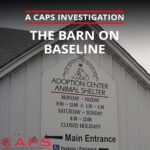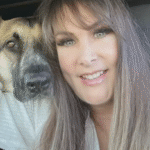Breeder: Mickelson, Cathy
Business name: C G M Kennel
Address: 29793 112 St.
City, State Zip: Herreid, SD 57632
Year: 2005
USDA License: 46-A-0267
Date of CAPS Investigation: 2005-07-23
Time of CAPS Investigation: 16:18
Breeds: Cocker Spaniels, Poodles, Bichon Frises
On the property at the time of investigation: about 34 dogs and 3 puppies
There were two kennel structures were on the property, both containing enclosures with indoor/outdoor cages.
First building
One of the structures had enclosures that rested on the ground; each enclosure contained two Cocker Spaniels. The outdoor pens were concrete runs surrounded by chain link fencing. The back walls of these pens were plastic with metal doggie-doors providing access to the indoor pens. The plastic walls had fecal stains on their surfaces, and there was several days’ accumulation of feces covering the floor of each pen. The dogs had nowhere to walk or lie down without being in contact with their excrement (3.1(c)(3)-Surfaces); (3.11(a)-Cleaning of primary enclosures). Metal water dishes on the floor of each pen were empty (3.10-Watering).
The edge of the concrete slabs furthest from the kennel building had a thick build-up of hair and feces, as though the waste had been washed from the pens and allowed to accumulate there for several weeks without being removed (3.1(f)-Drainage and waste disposal).
Four of the enclosures had indoor pens constructed with plastic walls and floors; wooden doors provided access from inside the kennel building. All of surfaces of the pens were stained with feces, and the floorings were caked with feces. The dogs could not walk or lie down inside without being on top of the filth (3.1(c)(3)-Surfaces); (3.11(a)-Cleaning).
Two pens contained rugs that were soaked with urine and covered in dried excrement (3.1(c)(3)-Surfaces). Plastic self-feeders attached to the doors of inside pen also had feces caked to their surfaces (3.9(b)-Feeding).
More than a day’s worth of food was in each feeder, indicating the dogs are not fed every day, but instead given several days of food at once so that they eat progressively older food over time (3.9(a)-Feeding).
This building was a shed with a short walkway with the pens on one side, and crates, cages, spare cage parts, and plastic bucket stored within three feet of them on the other side (3.1(b)-Condition and site). Food bags were stored on top of the pens themselves (3.1(e)-Storage). The walkway to the kennel itself was covered in a dirty build-up (3.1(c)(1)-Surfaces).
Second building
The second kennel building contained a dozen enclosures. There two dogs – Bichons, Cocker Spaniels, or Poodles – per enclosure. One cage housed two puppies and another housed a single puppy.
The enclosures, indoor and outdoor, were constructed with plastic beams and treated wire. Plastic self feeders and water bottles were connected to the indoor enclosures. The puppy cages had pieces of dirty carpet. Heat lamps, some of which were covered in rust, hung from the cage ceilings (3.1(c)(1)(i)-Surfaces). There was a dirty build-up on the hallway floor of the kennel (3.1(c)(1)-Surfaces).
Download attachments:Mickelson.pdf




